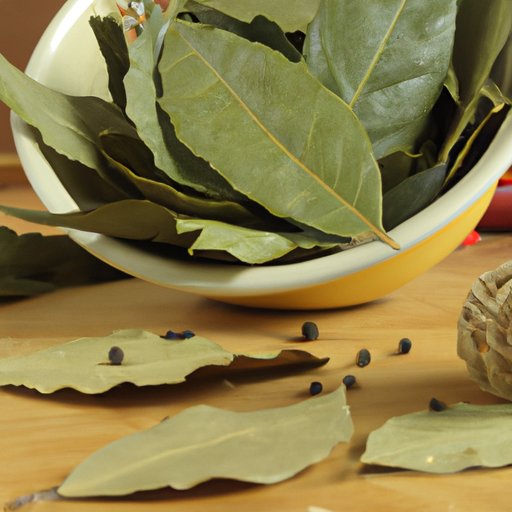Introduction
Bay leaves are a common ingredient in many different cuisines, from Mediterranean to Indian. But what do bay leaves do in cooking? And why should you use them? In this article, we’ll explore the benefits and creative uses of bay leaves in cooking, as well as some tips for getting the most out of them.
What Are Bay Leaves?
Bay leaves, also known as laurel leaves, are aromatic leaves of the bay laurel tree, which is native to the Mediterranean region. They are typically used dried, although fresh bay leaves can be found in some areas. The leaves have a sharp, bitter taste that mellows when cooked. They are often used in soups, stews, marinades, and other dishes.
Benefits of Cooking with Bay Leaves
Cooking with bay leaves has several advantages. First, they add a distinct flavor and aroma to dishes. The leaves have an earthy, slightly sweet taste that pairs well with many types of foods. Additionally, bay leaves are high in vitamins A, C, and B6, as well as calcium and magnesium. These vitamins and minerals can help boost the nutritional value of a dish.

Exploring the Flavor and Aroma of Bay Leaves in Cooking
So how do bay leaves enhance food? Bay leaves impart a subtle but complex flavor that can really elevate a dish. They also release a pleasant, herbal aroma when cooked, adding another layer of flavor to a meal. While the flavor and aroma of bay leaves are mild, they can still be quite noticeable if used correctly.
Adding Depth to Dishes
Bay leaves can also be used to add depth to dishes. Adding a few bay leaves to a stew or soup can give it a richer flavor, while using them in marinades can infuse meats and vegetables with a unique flavor. They can also be used to make flavorful stocks and broths.

Creative Uses for Bay Leaves: Maximizing the Flavors of Your Dishes
Once you understand what bay leaves do in cooking, you can start to get creative with them. Here are some tips for unlocking the unique flavor of bay leaves and maximizing the flavors of your dishes:
Unlocking the Unique Flavor of Bay Leaves
The flavor of bay leaves is released slowly, so it’s best to give them plenty of time to cook. For soups and stews, add the bay leaves at the beginning and let them simmer for at least an hour. For marinades, soak the leaves in oil or vinegar overnight before adding them to the dish. This will allow the flavors to really develop.
Tips for Enhancing the Flavor of Your Dish
To really bring out the flavor of the bay leaves, try crushing them before adding them to the dish. This will help release the essential oils and intensify the flavor. You can also experiment with adding different spices and herbs to complement the flavor of the bay leaves. Garlic and thyme pair particularly well with bay leaves.
An Introduction to Cooking with Bay Leaves: A Comprehensive Guide
Now that you know what bay leaves do in cooking, here’s a comprehensive guide to get you started. Here are some ingredients to consider when cooking with bay leaves:
- Meats: beef, pork, chicken, fish, etc.
- Vegetables: onions, potatoes, carrots, mushrooms, etc.
- Herbs and spices: oregano, thyme, garlic, pepper, etc.
- Liquids: broth, wine, vinegar, etc.

Best Practices for Cooking with Bay Leaves
When cooking with bay leaves, it’s important to follow some basic guidelines. Here are some tips for getting the most out of your bay leaves:
- Always use whole bay leaves rather than ground, as ground bay leaves will lose their flavor quickly.
- Add the bay leaves at the beginning of cooking, as they need time to release their flavor.
- Be sure to remove the bay leaves before serving, as they can be sharp and difficult to chew.
- If using fresh bay leaves, double the amount called for in the recipe.
Conclusion
Bay leaves are a versatile and flavorful ingredient that can be used to add depth and complexity to a variety of dishes. They have a subtle yet distinctive flavor and aroma, and can be used to enhance the flavor of meats, vegetables, soups, stews, and more. By following these tips and best practices, you can unlock the unique flavor of bay leaves and maximize the flavors of your dishes.

Summary of Benefits of Cooking with Bay Leaves
In summary, cooking with bay leaves offers a range of benefits, including:
- A distinct flavor and aroma
- Nutritional value
- Depth and complexity to dishes
- Versatility in a variety of dishes
Final Thoughts
Bay leaves are an easy way to add flavor and aroma to any dish. With a few simple tips and best practices, you can unlock the unique flavor of bay leaves and maximize the flavors of your dishes.


